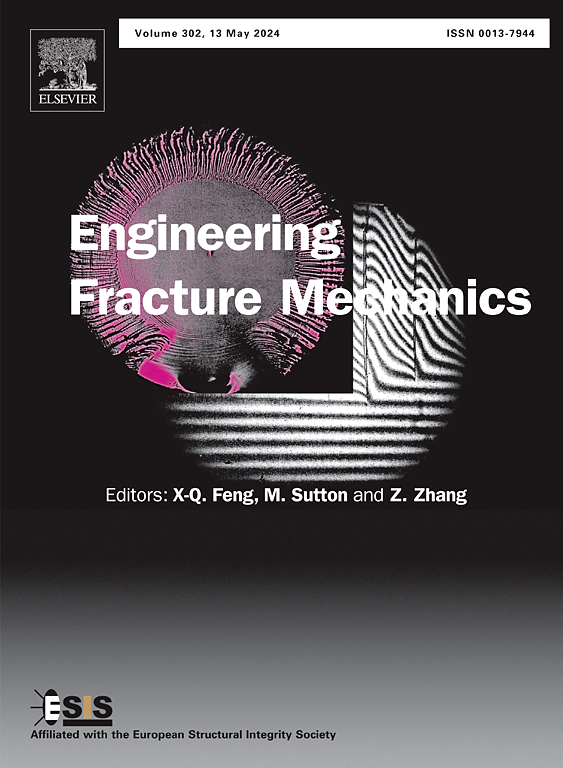粗集料对混凝土抗接触爆炸性的影响--介观研究
IF 4.7
2区 工程技术
Q1 MECHANICS
引用次数: 0
摘要
混凝土的力学性能与其内部微观结构之间存在着错综复杂的关系,这凸显了在中观层面理解爆炸性能和破坏机制以有效提高抗爆性能的重要性。本研究采用三维(3D)中观模型对掺有粗骨料的混凝土在接触爆炸下的动态行为进行了数值研究。通过接触爆炸试验对数值模型和模拟技术进行了严格验证。研究探索了随机分布粗集料的异质混凝土目标的中观破坏机制,并与均质混凝土目标进行了比较。深入研究了影响混凝土抗接触爆炸性的关键中观参数。粗集料的结构效应至关重要,它将破坏模式从均质混凝土中以剥落为主的整体破坏转变为中观混凝土中的局部破坏。中观混凝土经历了截然不同的四阶段破坏演化--开裂、裂缝萌生、穿孔和动态碎裂--与匀质混凝土不同,中观混凝土的多层剥落源于边界。在均质混凝土中观察到的冲击波指数衰减在中观混凝土中被粗骨料局部破坏,这归因于波阻抗失配和骨料挤出效应。砂浆强度主要导致混凝土开裂,对破坏模式的影响微乎其微。破坏模式主要受粗骨料含量和粒径的影响。较高的体积分数可显著减少混凝土的剥落,而粗骨料粒径的增加则会加剧穿孔破坏。这项综合研究推进了我们对中观层面抗爆混凝土设计的理解,为旨在增强结构韧性的策略提供了宝贵的见解。本文章由计算机程序翻译,如有差异,请以英文原文为准。
Effect of coarse aggregates on contact explosion resistance of concrete—A mesoscopic investigation
The intricate relationship between the mechanical properties of concrete and its internal microstructure underscores the importance of comprehending explosion performance and damage mechanisms at a mesoscopic level to effectively enhance blast resistance. This study employed three-dimensional (3D) mesoscale models to numerically investigate the dynamic behavior of concrete mixed with coarse aggregates under contact explosion. Rigorous validation of numerical models and simulation techniques was untaken through the contact explosion tests. The study explored mesoscopic damage mechanisms in heterogeneous concrete targets with randomly distributed coarse aggregates, drawing comparisons with a homogeneous concrete target. Critical mesoscopic parameters influencing the contact explosion resistance of concrete were thoroughly examined. Structural effects of coarse aggregates emerge as pivotal, shifting the damage mode from overall failure with spalling-dominated damage in homogeneous concrete to localized failure in mesoscopic concrete. The mesoscopic concrete experienced a distinct four-stage damage evolution—cratering, crack initiation, perforation, and dynamic fragmentation—diverging from homogeneous concrete with multi-layer spalling originating from the boundaries. The exponential attenuation of shock waves observed in homogeneous concrete was locally disrupted by coarse aggregates in mesoscopic concrete, attributed to wave impedance mismatch and aggregate extrusion effects. Mortar strength primarily contributed to concrete cracking, with minimal impact on damage modes. Failure modes were predominantly influenced by the content and particle size of coarse aggregates. Higher volumetric fractions significantly reduced concrete spalling, while increased coarse aggregate size exacerbated perforation failure. This comprehensive study advances our understanding of blast-resistant concrete design at a mesoscopic level, providing valuable insights for strategies aimed at enhancing structural resilience.
求助全文
通过发布文献求助,成功后即可免费获取论文全文。
去求助
来源期刊
CiteScore
8.70
自引率
13.00%
发文量
606
审稿时长
74 days
期刊介绍:
EFM covers a broad range of topics in fracture mechanics to be of interest and use to both researchers and practitioners. Contributions are welcome which address the fracture behavior of conventional engineering material systems as well as newly emerging material systems. Contributions on developments in the areas of mechanics and materials science strongly related to fracture mechanics are also welcome. Papers on fatigue are welcome if they treat the fatigue process using the methods of fracture mechanics.

 求助内容:
求助内容: 应助结果提醒方式:
应助结果提醒方式:


